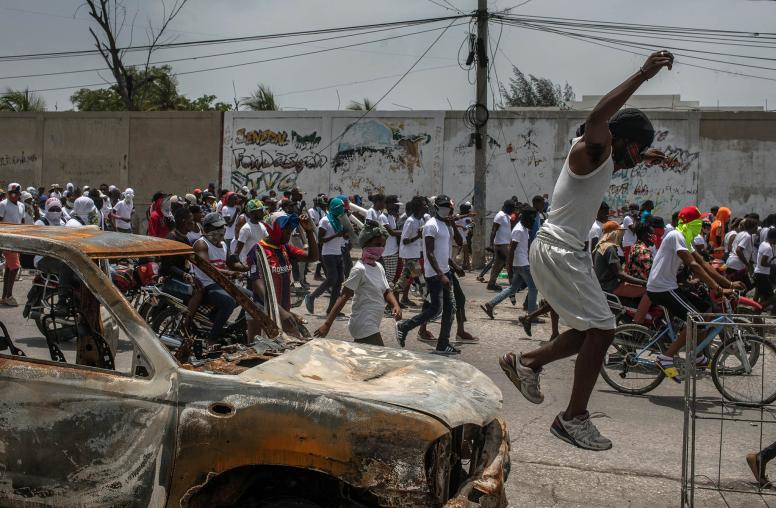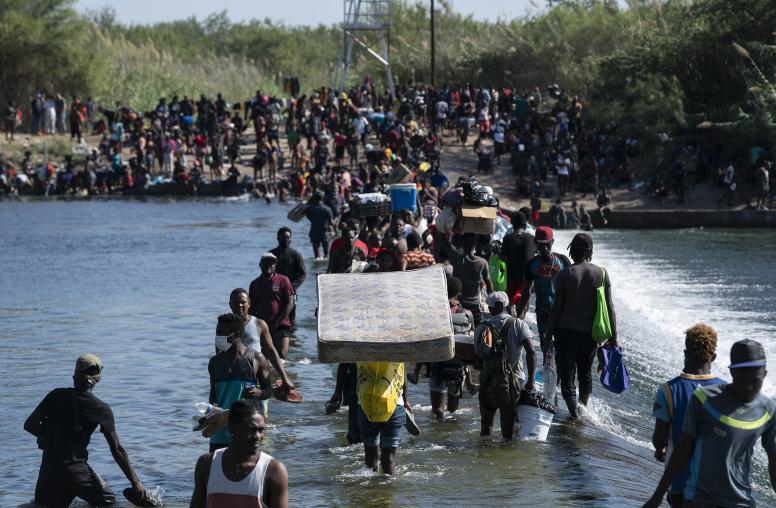There is a Path Forward in Haiti — But It’s Not the One We Are On
Haiti desperately needs a functioning transitional government. An internationally facilitated political process may be the only way to get one.
There are few international crises where the tension between international assistance and locally led solutions is in greater conflict than Haiti. Failure to get that balance right goes a long way toward explaining the failure to solve the crisis for the two long years since the assassination of Haiti’s president. The country has a long list of needs, including on pressing, immediate issues like food security, health care, rampant gang violence and education. Ultimately, Haiti needs a credible and transparent election to reset its political system. But the functioning transitional government it requires is something that can best be achieved through an assertive political process that blends outside assistance with independent local actors, bringing together all key stakeholders under international facilitation.

Searching for a Model Process
I was part of a 1994 political process in Somalia led by U.N Special Representative Lansanas Kouyate that offers a good model. The fall of Somali dictator Mohamed Siad Barre in 1991 led to a civil war among a host of competition factions. U.N. peacekeepers pulled back after the Black Hawk Down debacle in 1993, leaving the forces of Mohammed Farah Aidid first among equals in clan clashes that were destabilizing the country. Kouyate’s interpersonal skills and deep understanding of Somalia’s clan dynamics were without equal, and he saw an opportunity after a flareup of fighting in Kismayo. He convened the clan leaders in Nairobi for talks — first 30, then 40 and ultimately around 60 to cover all the various interests and sub-factions.
For two weeks Kouyate listened, cajoled and implored — in groups small and large, in pairs and trios, by clans and sub-clans. He was respectful, informed, patient, gregarious, tough and realistic. It was a masterful performance of the diplomacy of peacebuilding. We edged closer to an agreement, but it was still elusive. At one point, messages came in through women’s organizations in Mogadishu that if the clan leaders had any expectation of resuming normal conjugal relations upon their return, they had better show up with an agreement.
One evening we told the hotel to inform the clan leaders they were on their own for their hotel bill after the next morning and would no longer be welcome at the generous buffet. Bell caps came around to tag their bags for shipment back to Somalia. They thought to call our bluff. But a 2 a.m. knock on Kouyate’s door, who was sleeping soundly, finally revealed that they accepted the jig was up.
Was it a “Somali solution?” I found out the next day when I tried to organize the signing ceremony in classic Western symmetry with six chairs on one side and six on the other. They immediately re-organized the room with nine on one side and three on the other to reflect their true alignment, tearing up the program and informing us who would speak and in what order. It was their agreement. And it bought the country several years of relative peace.
Somalia may seem like an odd example, given its challenges in consolidating governance in the years since. But it has notably overcome these challenges over time, and has achieved a functional government, whose president was in Washington last week. This mediation effort was one of the first steps to the country’s recovery.
Lessons from the 1994 Process in Somalia
We learned several lessons that could be helpful to those wanting to assist Haiti today.
First, the fact that foreigners are involved does not make an agreement any less valid. Like the Somali clans before Kouyate’s intervention, Haitians have been trying alone to forge a governing agreement for two years. There has been tepid outside mediation support but not on the level required. At what point has the “Haitian solution” run its course?
Second, the formula for forging an agreement is not set, but getting there will require a very skilled and dedicated mediator, or team of mediators, who will stay with the process until it concludes — and then some. Kouyate stayed on in Somalia for a full year after the agreement was signed.
Third, it also demands assembling the right array of local actors who can make and enforce an agreement. It could be as many as 1,700 as in the first Afghan Loya Jirga, or as few as three or four, as in the Balkans or Tunisian quartet process. For Haiti, the number would most likely land between 60 and 80.
Fourth, the process cannot simply be open-ended. Kouyate imposed a reasonable timeline and was clear when there was nothing to be gained by more talks since simple intransigence and selfishness were the issues. Haiti’s crisis cannot be solved in a single weekend, but if the process requires more than two weeks of talks, the formula is likely wrong. Haiti has no tribes, nor clans, nor clashing religions. It has many key players with an excess of ambition, and that ambition can only be curtailed by some gentle exercise of outside persuasion.
Fifth, some kind of force, generally from outside, is needed to enforce an agreement, or at least provide basic security. A U.N. peacekeeping force held the peace in Somalia as it has at various times in Haiti. At present, the situation in Haiti is much more complicated because the agreement needed is a broad governing one among parties who are not fighting, in a country overrun by gangs who are. A modest outside security force will likely be needed to keep the gangs quiet as a political process advances, and the institutions of government reset.
A Starting Point
An assertive mediation effort led by a highly skilled individual or team with real gravitas, in support of a wide range of Haitian actors, would be the place to start. The June Kingston stakeholders’ meeting in Jamaica — under the auspices of the Caribbean Community’s eminent persons group, comprised of former prime ministers Dr. Kenny Anthony from Saint Lucia, Bruce Golding from Jamaica, and Perry Christie from the Bahamas — may have provided that starting point. It convened some 50 Haitian notables from political parties, the current government and civil society. Reports from the meeting were positive as the respectful setting provided a place where views could be exchanged and confidence built.
But the meeting did not include all parties and left the most challenging issues — executive branch formulation and power sharing — pending. And there are looming constitutional issues that relate directly to the holding of elections.
Some are seeing the Jamaica meeting as an essential confidence-building measure toward a lengthy process. At this stage, there should be no rush — that will only result in another badly designed agreement. But the next meeting, patiently and carefully planned inside Haiti, might be the place to finally bring the thorniest of issues to a resolution.
It should be possible to blend the various efforts to date from the interim government, the Montana Group, and December 21 Accord into a single functional governing architecture that the international community could fully endorse and support. The December 21 Accord notably brings a special arrangement for an interim legislature and public roundtables that should not be lost for the transparency and inclusion they would bring.
From a functional transitional government there is a still a very long road to an election, but it would at least provide the basic framework for working through the many issues of governance and security that will be required. And it would provide the needed anchor for humanitarian assistance to flow and stem the current near famine conditions many Haitians are facing.
When the United States decried armed nation-building in the aftermath of the predictable challenges in Iraq and Afghanistan, it threw away a host of other tools such as assertive mediation and support for foreign security forces as well. Haiti would be a good place to restore these tools.

